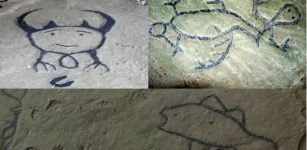Astonishing Lunar And Solar Calendars Created 30,000 B.C.
Ellen Lloyd - AncientPages.com - At first glance, these ancient artifacts may look like ordinary bones covered with insignificant dots. That is not the case, however.
Closer examination of carved-engraved bone plates discovered in France has revealed people created astonishing lunar and solar calendars 30,000 B.C.
Chauvet-Pont d'Arc cave replica, the lions "fresco". Credit: HTO - Public Domain
For as long as anyone can remember, people have been fascinated with the night skies. There are many examples of how our ancestors’ profound interest in astronomy.
Observations of celestial objects took place in many prehistoric societies. Today, we can admit that ancient astronomers possessed advanced knowledge about the Sun, the Moon, asteroids, various solar planets, and interesting cosmic events. When and where people started to study the heavens and celestial objects is impossible to say, but if we turn our attention to Europe, we discover something quite extraordinary.
European Paleolithic works of art can be dated to approximately 30 000 BC. and are considered one of the achievements of the Upper Paleolithic cognitive revolution. The earliest cave paintings in La Grotte Chauvet-Pont-d’Arc, France were created about 31 000 years ago. Not only are the images a great example of prehistoric art, but they have also motivated researchers to attempt to “decipher” the meaning and purpose behind some of the ancient symbols.
While examining Paleolithic cave art scientists discovered that Paleolithic people had a great interest in astronomy.
Alexander Marshack (1918-2004), an American independent scholar and Paleolithic archaeologist, was one of the first scientists who stated astronomy played an essential role during the Upper-Paleolithic era.
He studied ancient bone fragments discovered in French caves. He interpreted the various Paleolithic and Mesolithic, mostly portable, objects that bear engraved or painted series of dots or lines as accurate lunar observations.
Juan Antonio Belmonte writes in the book Ancient Astronomy: India, Egypt, China, Maya, Inca, Aztec, Greece, Rome, Genesis, Hebrews, Christians, the Neolithic and Paleolithic that Marshack’s “arguments were based not only on counting the signs but on what he called “microscopic analysis.”
The interpretation of the markings on various artifacts as notational systems rests on the hypothesis of a slow accumulation of these marks, which correlates with lunar or solar motion. Thus he concluded that these artifacts reflect nonarithmetic observational astronomical skills and lore. The most well-known depiction interpreted by him is found on the bone plate about 30 000 years old, from Abri Blanchard (Dordogne, France), which is said to represent the waxing and waning moon positions in serpentine form.”
Top: Abri Blanchard, Dordogne, France. Archaeological Museum. Bottom: Cave of Taï, Drôme, France
“Francesco d’Errico and colleagues developed a different type of methodology (d’Errico 1989). Drawing on experimental archaeology, they compiled a database in an attempt to demonstrate whether the notches represent notational systems or not.
After investigating a great number of artifacts they concluded that there were some objects which might have depicted parts of a series of complex codes based on the hierarchical organization of information, and using formally differentiated marks. One of these artifacts might be the find from the cave Taï (Drôme, France) whose age is about 10 000 years.
After studying Eurasian portable art the Russian investigator B.A. Frolov also became convinced that these objects were calendars following the monthly motion of the moon and/or yearly solar path, and claimed they were used by early communities. The most well-known bone plate interpreted as a lunisolar calendar is from Ma’lta (Irkutskaya Oblast, Russia).”
The theory that people created such complex lunar and solar calendars so long ago may sound somewhat far-fetched. Still, there is a lot of evidence that suggests our ancestors were rather familiar with the movements of the Sun, Moon, and even other planets.
Updated on March 22, 2022
Written by Ellen Lloyd – AncientPages.com
Copyright © AncientPages.com All rights reserved. This material may not be published, broadcast, rewritten or redistributed in whole or part without the express written permission of AncientPages.com
More From Ancient Pages
-
 Did Our Ancestors Know About Artificial Intelligence?
Ancient Technology | Sep 2, 2015
Did Our Ancestors Know About Artificial Intelligence?
Ancient Technology | Sep 2, 2015 -
 The Parthenon Marbles Evoke Particularly Fierce Repatriation Debates – An Archaeologist Explains Why
Artifacts | Jul 1, 2024
The Parthenon Marbles Evoke Particularly Fierce Repatriation Debates – An Archaeologist Explains Why
Artifacts | Jul 1, 2024 -
 Unsolved Mystery Of The Giant Footprints Outside The Ain Dara Temple
Featured Stories | Jun 7, 2014
Unsolved Mystery Of The Giant Footprints Outside The Ain Dara Temple
Featured Stories | Jun 7, 2014 -
 The Ancient Giants Who Ruled America: The Missing Skeletons And The Great Smithsonian Cover-Up
Biblical Mysteries | Apr 26, 2014
The Ancient Giants Who Ruled America: The Missing Skeletons And The Great Smithsonian Cover-Up
Biblical Mysteries | Apr 26, 2014 -
 On This Day In History: Battle Of Las Navas De Tolosa Was Fought – On July 16, 1212
News | Jul 16, 2016
On This Day In History: Battle Of Las Navas De Tolosa Was Fought – On July 16, 1212
News | Jul 16, 2016 -
 48,000-Year-Old Tooth That Belonged To Neanderthal Child Found In Northern Italy
Fossils | Sep 19, 2020
48,000-Year-Old Tooth That Belonged To Neanderthal Child Found In Northern Italy
Fossils | Sep 19, 2020 -
 Strange Case Of 17th-Century Child Mummy Hidden From The Sun – What Does Virtual Autopsy Reveal?
Archaeology | Oct 26, 2022
Strange Case Of 17th-Century Child Mummy Hidden From The Sun – What Does Virtual Autopsy Reveal?
Archaeology | Oct 26, 2022 -
 Ancient Warfare And Continuous Rise In Global Population – Is There A Connection?
Archaeology | Sep 13, 2021
Ancient Warfare And Continuous Rise In Global Population – Is There A Connection?
Archaeology | Sep 13, 2021 -
 Ancient Mystery Of The Leo Petroglyphs In Ohio Created By An Unknown Native American Culture
Featured Stories | Dec 21, 2020
Ancient Mystery Of The Leo Petroglyphs In Ohio Created By An Unknown Native American Culture
Featured Stories | Dec 21, 2020 -
 Top 10 Discoveries About Our Ancient Ancestors In 2023
Archaeology | Dec 29, 2023
Top 10 Discoveries About Our Ancient Ancestors In 2023
Archaeology | Dec 29, 2023 -
 New Evidence Of Human Habitation At Panga ya Saidi Cave, Kenya That Dates Back 78,000 Years
Archaeology | May 11, 2018
New Evidence Of Human Habitation At Panga ya Saidi Cave, Kenya That Dates Back 78,000 Years
Archaeology | May 11, 2018 -
 Researchers Use 21st Century Methods To Record 2,000 Years Of Ancient Graffiti In Egypt
Archaeology | Mar 31, 2023
Researchers Use 21st Century Methods To Record 2,000 Years Of Ancient Graffiti In Egypt
Archaeology | Mar 31, 2023 -
 Spread Of Transeurasian Languages Was Due To Agriculture Study Reveals
Archaeology | Nov 10, 2021
Spread Of Transeurasian Languages Was Due To Agriculture Study Reveals
Archaeology | Nov 10, 2021 -
 Forbidden Knowledge: Secret Ancient Gates Of The Shining Ones – More Surprising Discoveries – Part 3
Featured Stories | Jul 19, 2019
Forbidden Knowledge: Secret Ancient Gates Of The Shining Ones – More Surprising Discoveries – Part 3
Featured Stories | Jul 19, 2019 -
 Kanishka Casket – Beautiful Ancient Buddhist Treasure In Gilded Copper
Featured Stories | Jun 14, 2021
Kanishka Casket – Beautiful Ancient Buddhist Treasure In Gilded Copper
Featured Stories | Jun 14, 2021 -
 Huge Maya Civilization With Pyramids, Settlements, Ball Courts, Roads And More Discovered By LIDAR In Guatemala
Archaeology | Dec 30, 2022
Huge Maya Civilization With Pyramids, Settlements, Ball Courts, Roads And More Discovered By LIDAR In Guatemala
Archaeology | Dec 30, 2022 -
 Islands Of The Tropical Pacific Ocean Were Settled Much Earlier Than Previously Thought – New Theory
Archaeology | Dec 20, 2022
Islands Of The Tropical Pacific Ocean Were Settled Much Earlier Than Previously Thought – New Theory
Archaeology | Dec 20, 2022 -
 Mysterious Gigantic Jars Of Unknown Origin Discovered Worldwide
Artifacts | Dec 27, 2018
Mysterious Gigantic Jars Of Unknown Origin Discovered Worldwide
Artifacts | Dec 27, 2018 -
 January 2016: Lost Library Of John Dee Revealed In A Special Exhibition
Archaeology | Jan 24, 2016
January 2016: Lost Library Of John Dee Revealed In A Special Exhibition
Archaeology | Jan 24, 2016 -
 Curious Bannerstones Used By Prehistoric Native Americans For Unknown Purpose
Artifacts | May 31, 2021
Curious Bannerstones Used By Prehistoric Native Americans For Unknown Purpose
Artifacts | May 31, 2021



